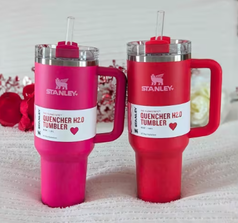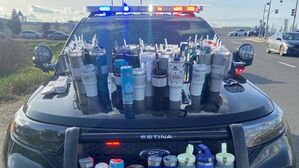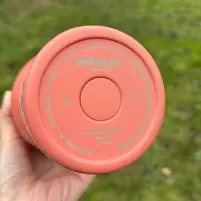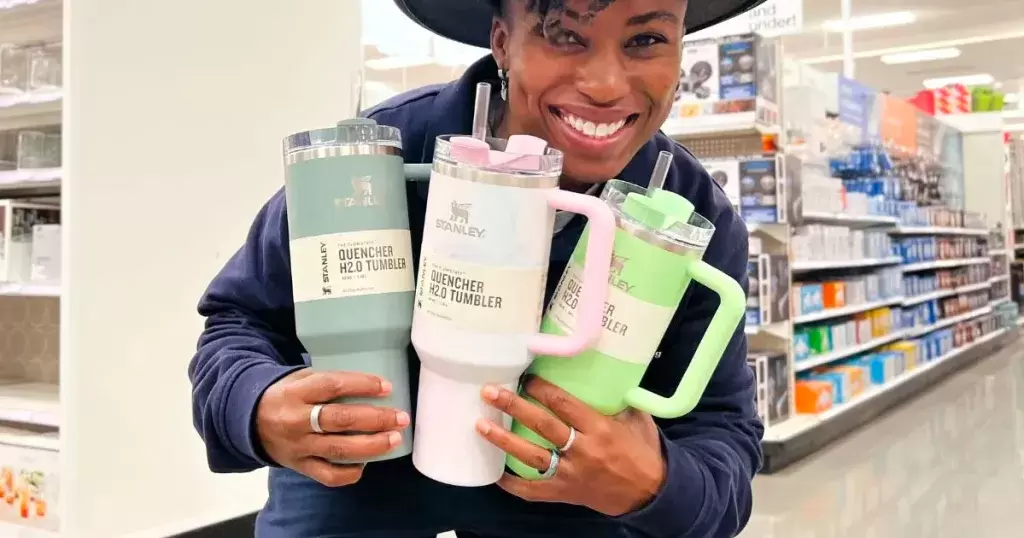"Stanleys are everywhere–TikTok, Instagram, YouTube, Target, schools, and workplaces. Almost everyone has heard of them, but not the whole story"--Zanthe Jones-Gerachis, 8th grade

Stanleys are everywhere–TikTok, Instagram, YouTube, Target, schools, and workplaces. Almost everyone has heard of them and the chaos surrounding them, including customers getting in physical fights just to get the newest release, shoplifting, and even bullying. But the real question is, why now? Stanley water bottles have been around since 1913, so what’s changed?
For those who do not know, Stanleys (Stanley Tumblers) are a quality water bottle line famous for their ability to hold a lot of liquid and keep water cold/hot while still fitting in cup holders, and having the appeal of aesthetic—monochrome and pastels, especially. But recently, Stanleys have become a lot more popular. The real chaos first started around late December, with customers rushing to buy Stanleys for the holidays.
This hit a boiling point when customers waited for Target to open so they could run inside, some physically harming other customers just to get the limited-edition Target Valentines Day’ Stanley. The Valentine’s Day Stanley is a hot pink or red, with a handle and straw. But really, what’s the appeal?
For those who do not know, Stanleys (Stanley Tumblers) are a quality water bottle line famous for their ability to hold a lot of liquid and keep water cold/hot while still fitting in cup holders, and having the appeal of aesthetic—monochrome and pastels, especially. But recently, Stanleys have become a lot more popular. The real chaos first started around late December, with customers rushing to buy Stanleys for the holidays.
This hit a boiling point when customers waited for Target to open so they could run inside, some physically harming other customers just to get the limited-edition Target Valentines Day’ Stanley. The Valentine’s Day Stanley is a hot pink or red, with a handle and straw. But really, what’s the appeal?

This craze has even gone to the point where a woman stole 65 Stanleys from a Target in California.
“Roseville Police officers responded to a report of a theft at a retail store where staff “saw a woman take a shopping cart full of Stanley water bottles without paying for them,” and refused to stop for staff, police said on Facebook.”
“An officer saw the unidentified 23-year-old woman’s vehicle travel on a nearby highway, pulled her over and arrested her for grand theft. After a search of the car, the police recovered 65 Stanley cups,” CNN reported.
The woman's reasoning for this is unknown, but one can guess. With customers camping out at Target and running to get the newest expensive Stanley, the temptation to make a buck is too much for some. Stanleys are expensive, however it was still surprising when the stolen 65 Stanleys added up to $2,500.
The sudden need to have all of these Stanleys just to put them on a shelf, or parade them around as if it gives a person status is unexplainable. Each Stanley has a different color, design, or customization, but is that really the only reason Stanleys have become so popular?
“I think they've gotten really popular recently because famous influencers like Alix Earle and Katie Fang found or–I guess–‘discovered’ Stanleys, even though Stanleys were already a thing,” said Cb Omand, an 8th grade OSA student who owns a Stanley. “It's a nice cup, I like it a lot because you don't have to open anything to drink it. The straws are just right there. But I dont think it's like something revolutionary and new,” Omand explains.
The Stanley craze has become another trend that’s been acquired by the same demographic , kids. You may have heard of Sephora Kids, who are kids under the age of 12 typically wearing LuluLemon, owning Stanleys, and going to Sephora to get makeup and skincare they don't need. Sephora Kids are typically the kids who want the Stanleys, and it has become a widely-known stereotype. For more about Sephora kids and their behaviors look at Cb Omand’s article: “The Tween Takeover of Sephora”
All of this behavior associated with Stanleys has even come to the point where people are afraid of judgment about having one, because they don't want to be characterized as a Sephora kid—that is, someone who is “basic” or “preppy,” as well as someone who is chronically online and blindly follows trends.
“What if they think I’m basic? What if they think I assaulted someone at a Target in order to get it? (And which is worse?)” worried Heather Schwedel in her article “I Spent a Week Parading My Coveted Stanley Cup Around New York City.”
These worries have even led some people to decide not to get one at all. People are worried about getting bullied for not having one, but then they get one and suddenly they are characterized as a rich “preppy” and basic person.
“Roseville Police officers responded to a report of a theft at a retail store where staff “saw a woman take a shopping cart full of Stanley water bottles without paying for them,” and refused to stop for staff, police said on Facebook.”
“An officer saw the unidentified 23-year-old woman’s vehicle travel on a nearby highway, pulled her over and arrested her for grand theft. After a search of the car, the police recovered 65 Stanley cups,” CNN reported.
The woman's reasoning for this is unknown, but one can guess. With customers camping out at Target and running to get the newest expensive Stanley, the temptation to make a buck is too much for some. Stanleys are expensive, however it was still surprising when the stolen 65 Stanleys added up to $2,500.
The sudden need to have all of these Stanleys just to put them on a shelf, or parade them around as if it gives a person status is unexplainable. Each Stanley has a different color, design, or customization, but is that really the only reason Stanleys have become so popular?
“I think they've gotten really popular recently because famous influencers like Alix Earle and Katie Fang found or–I guess–‘discovered’ Stanleys, even though Stanleys were already a thing,” said Cb Omand, an 8th grade OSA student who owns a Stanley. “It's a nice cup, I like it a lot because you don't have to open anything to drink it. The straws are just right there. But I dont think it's like something revolutionary and new,” Omand explains.
The Stanley craze has become another trend that’s been acquired by the same demographic , kids. You may have heard of Sephora Kids, who are kids under the age of 12 typically wearing LuluLemon, owning Stanleys, and going to Sephora to get makeup and skincare they don't need. Sephora Kids are typically the kids who want the Stanleys, and it has become a widely-known stereotype. For more about Sephora kids and their behaviors look at Cb Omand’s article: “The Tween Takeover of Sephora”
All of this behavior associated with Stanleys has even come to the point where people are afraid of judgment about having one, because they don't want to be characterized as a Sephora kid—that is, someone who is “basic” or “preppy,” as well as someone who is chronically online and blindly follows trends.
“What if they think I’m basic? What if they think I assaulted someone at a Target in order to get it? (And which is worse?)” worried Heather Schwedel in her article “I Spent a Week Parading My Coveted Stanley Cup Around New York City.”
These worries have even led some people to decide not to get one at all. People are worried about getting bullied for not having one, but then they get one and suddenly they are characterized as a rich “preppy” and basic person.

This characterization has even gone so far that SNL made a skit about it titled “Big Dumb Cups.” The skit parodies the type of people buying Stanleys, making fun of the size of the Stanleys and their leakage.
“I will not be getting a Stanley because they are basic,” stated Abigail Ambrose, an 8th grade OSA student. When asked if she thought she would be judged for having one she agreed and said yes.
“It's the Lulu Melon [referring to Lululemon] girls guys! Yes, I’m telling you!” explains Estella Moore, an 8th grade student at OSA. “It's them!” agreed Yaretzi Condado, another 8th grade OSA student.
“These little girls are getting bullied because they don't have it! It’s like [the] Stanley apocalypse guys!” explains Moore. “Also, the whole Target-Starbucks Stanley thing where I saw people lining up before like… the day…began. And like, hello! You could have been sleeping! Like me!” Moore stated enthusiastically.
As Moore mentioned, many young girls are getting bullied at their schools for not having a $45 cup that is bigger than their head. A mom on Youtube shared that she had bought her daughter a dupe Stanley Tumbler from Walmart for Christmas. The mom continued to say she didn't think a nine year old needed a Stanley cup, but when her daughter went to school she got bullied by other young girls for not having a real Stanley.
But what happens in a year, when Stanleys are gone and it’s an “old trend”? This is exactly what happened with Hydro Flasks in 2019. People who had Hydroflasks were named as “vsco girls” which was cool, until it wasn't.
“They are going to fade out in a year. They are gross and weird,” stated Nathaniel DuBois confidently, OSA’s 8th grade representative.
“They're boring, they're expensive, and also, I know that all the people who have them, probably had a hydro flask at one point or any other water bottle that they could be using but they, you know, had to buy their ‘cool new Stanley’ to fit in with everyone,” explains Annika Houde, an 8th grade student at OSA.
Of course, younger kids aren't the only ones buying Stanleys, and not just girls. Stanleys have begun to be marketed more to women in their 20s and over, or moms. But when they first started they were more gender-neutral. Now Stanleys are mostly owned by Gen Z women, stay-at-home moms, and children from the ages of 8-18.
“I will not be getting a Stanley because they are basic,” stated Abigail Ambrose, an 8th grade OSA student. When asked if she thought she would be judged for having one she agreed and said yes.
“It's the Lulu Melon [referring to Lululemon] girls guys! Yes, I’m telling you!” explains Estella Moore, an 8th grade student at OSA. “It's them!” agreed Yaretzi Condado, another 8th grade OSA student.
“These little girls are getting bullied because they don't have it! It’s like [the] Stanley apocalypse guys!” explains Moore. “Also, the whole Target-Starbucks Stanley thing where I saw people lining up before like… the day…began. And like, hello! You could have been sleeping! Like me!” Moore stated enthusiastically.
As Moore mentioned, many young girls are getting bullied at their schools for not having a $45 cup that is bigger than their head. A mom on Youtube shared that she had bought her daughter a dupe Stanley Tumbler from Walmart for Christmas. The mom continued to say she didn't think a nine year old needed a Stanley cup, but when her daughter went to school she got bullied by other young girls for not having a real Stanley.
But what happens in a year, when Stanleys are gone and it’s an “old trend”? This is exactly what happened with Hydro Flasks in 2019. People who had Hydroflasks were named as “vsco girls” which was cool, until it wasn't.
“They are going to fade out in a year. They are gross and weird,” stated Nathaniel DuBois confidently, OSA’s 8th grade representative.
“They're boring, they're expensive, and also, I know that all the people who have them, probably had a hydro flask at one point or any other water bottle that they could be using but they, you know, had to buy their ‘cool new Stanley’ to fit in with everyone,” explains Annika Houde, an 8th grade student at OSA.
Of course, younger kids aren't the only ones buying Stanleys, and not just girls. Stanleys have begun to be marketed more to women in their 20s and over, or moms. But when they first started they were more gender-neutral. Now Stanleys are mostly owned by Gen Z women, stay-at-home moms, and children from the ages of 8-18.

Even though there is so much hype about Stanleys in social media and the world right now, recent reports are questioning the lead safety of Stanley cups.
“The company seals the base of its products with a material that ‘includes some lead,’ reported the Washington Post reported in an article written by Teddy Amenabar and Heidi Pérez-Moreno, “Are Stanley tumblers safe? Here’s what to know about lead in drinkware.”
“That seal is covered with stainless steel, and the lead doesn’t come into contact with your drink or your skin, the company says,”
“Most people think of lead poisoning as a thing of the past, but lead is still all around us, often at dangerous enough levels to cause significant harm,” explained Jenna Forsyth, Ph.D., research scientist specializing in epidemiology and environmental science at Stanford University School of Medicine, in an interview with Today.
However, Stanley insists their cups are safe, explaining, “on the bottom of each quencher made by the beverage container powerhouse is a circular barrier made of stainless steel, which covers a pellet that contains lead, a spokesperson for Stanley explains. The pellet seals the product's vacuum insulation, and it is not accessible unless the stainless steel barrier comes off — which is possible but “rare,” the Stanley spokesperson notes.” Explains Daryl Austin in his article on Today, Do Stanley cups contain lead or pose a risk of lead poisoning? Experts weigh in “In a recent flurry of social media posts, some Stanley customers say they are using at-home tests to assess if there’s lead in any of their Stanley products, to mixed results (though it’s often not clear what part of the cup is being tested and the quality of lead test being used). Some users have posted videos of themselves throwing their Stanley cups in the trash.”
Even though spokespeople and even some professionals have said there is really no risk for lead, owners of Stanleys have been weighing in. Multiple sources on the internet have said that the plate that covers the lead is hard to get off, but it’s not as “rare” as Stanley claims. Even so, Stanleys are still mostly safe, but if the bottom circle comes off, the lead will be exposed.
“At first it worried me, but I don't use my Stanley anymore, like, a lot because I lost it at school, [and was later found] so I just stopped bringing it to school. I've done some research on it, and so have my parents, just to make sure I'm safe, because the day that I got it they had watched a video on how there's lead in your Stanley.” Explains Kaliyah Smith, 7th grade OSA student and owner of a Stanley.
With a scare like that, it’s hard to come back. Especially when more people start testing their Stanleys for lead, and finding it.
Stanleys are famous for being durable, holding large amounts of water while keeping it insulated, and still having the appeal of looks, but one component has been disregarded: leaking.
When asked about the leakage of her Stanley, Smith responded enthusiastically, saying; “YES! Dude, it leaked everywhere! It leaked in my bag, it leaked on my floor, it leaked on my bed, it leaked on my table, it leaked everywhere! And it's so annoying!” Smith explained. “And I know there are like toppers… for.. Like so your Stanley doesn't leak but it still leaks out of the lid if you dont close it right. You have to buy them separately. Like I'm not– it's 5$ for three tiny little things.”
“They leak. You can't put them in your backpack like no,” said Mila Boyden, 8th grade OSA student.
Stanleys are popular for looks, and other things but mostly looks. But, even that is failing them.
“Everything I’d read before clicking “add to cart,” which was a lot, had given me the impression that part of the appeal of Stanleys was how pretty they were and what cute colors they came in. I expected something pastel and girly that would instantly please me every time I looked at it. But this was … cold and neutral. Tasteful? Blech.” said Schwedel
After contemplating all of these factors–leaking, bias, characterization, lead, and bullying–it's clear that Stanleys seem like they are starting to fade from the newest trends. Now, it's up to the Influencers who started the Stanley hyperfixation to start it again.
To see what happened in Target follow this link: https://www.youtube.com/watch?v=2pPTJpRMHb8
“The company seals the base of its products with a material that ‘includes some lead,’ reported the Washington Post reported in an article written by Teddy Amenabar and Heidi Pérez-Moreno, “Are Stanley tumblers safe? Here’s what to know about lead in drinkware.”
“That seal is covered with stainless steel, and the lead doesn’t come into contact with your drink or your skin, the company says,”
“Most people think of lead poisoning as a thing of the past, but lead is still all around us, often at dangerous enough levels to cause significant harm,” explained Jenna Forsyth, Ph.D., research scientist specializing in epidemiology and environmental science at Stanford University School of Medicine, in an interview with Today.
However, Stanley insists their cups are safe, explaining, “on the bottom of each quencher made by the beverage container powerhouse is a circular barrier made of stainless steel, which covers a pellet that contains lead, a spokesperson for Stanley explains. The pellet seals the product's vacuum insulation, and it is not accessible unless the stainless steel barrier comes off — which is possible but “rare,” the Stanley spokesperson notes.” Explains Daryl Austin in his article on Today, Do Stanley cups contain lead or pose a risk of lead poisoning? Experts weigh in “In a recent flurry of social media posts, some Stanley customers say they are using at-home tests to assess if there’s lead in any of their Stanley products, to mixed results (though it’s often not clear what part of the cup is being tested and the quality of lead test being used). Some users have posted videos of themselves throwing their Stanley cups in the trash.”
Even though spokespeople and even some professionals have said there is really no risk for lead, owners of Stanleys have been weighing in. Multiple sources on the internet have said that the plate that covers the lead is hard to get off, but it’s not as “rare” as Stanley claims. Even so, Stanleys are still mostly safe, but if the bottom circle comes off, the lead will be exposed.
“At first it worried me, but I don't use my Stanley anymore, like, a lot because I lost it at school, [and was later found] so I just stopped bringing it to school. I've done some research on it, and so have my parents, just to make sure I'm safe, because the day that I got it they had watched a video on how there's lead in your Stanley.” Explains Kaliyah Smith, 7th grade OSA student and owner of a Stanley.
With a scare like that, it’s hard to come back. Especially when more people start testing their Stanleys for lead, and finding it.
Stanleys are famous for being durable, holding large amounts of water while keeping it insulated, and still having the appeal of looks, but one component has been disregarded: leaking.
When asked about the leakage of her Stanley, Smith responded enthusiastically, saying; “YES! Dude, it leaked everywhere! It leaked in my bag, it leaked on my floor, it leaked on my bed, it leaked on my table, it leaked everywhere! And it's so annoying!” Smith explained. “And I know there are like toppers… for.. Like so your Stanley doesn't leak but it still leaks out of the lid if you dont close it right. You have to buy them separately. Like I'm not– it's 5$ for three tiny little things.”
“They leak. You can't put them in your backpack like no,” said Mila Boyden, 8th grade OSA student.
Stanleys are popular for looks, and other things but mostly looks. But, even that is failing them.
“Everything I’d read before clicking “add to cart,” which was a lot, had given me the impression that part of the appeal of Stanleys was how pretty they were and what cute colors they came in. I expected something pastel and girly that would instantly please me every time I looked at it. But this was … cold and neutral. Tasteful? Blech.” said Schwedel
After contemplating all of these factors–leaking, bias, characterization, lead, and bullying–it's clear that Stanleys seem like they are starting to fade from the newest trends. Now, it's up to the Influencers who started the Stanley hyperfixation to start it again.
To see what happened in Target follow this link: https://www.youtube.com/watch?v=2pPTJpRMHb8


